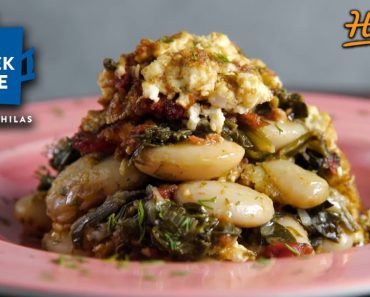
Giant Double Corn Pancake topped with fresh tomato and chili salsa and Greek yogurt. (Derek Davis/Staff Photographer)
When you are trying to eat as locally as possible, cooking matters because Maine farmers generally bring raw products to market. When you are trying to stretch a food budget, cooking matters because whole ingredients cost less than prepared foods. When you’re trying to eat in a healthy manner, cooking matters because you have direct control over the protein, fiber, fat, sugar and sodium content in the dishes you cook.

Chris Bourgoin, of South Paris, shreds cheese for macaroni and cheese and broccoli recipe made during the last of six Cooking Matters classes hosted by Healthy Oxford Hills in August, 2024, as Catrine Johndro looks on. Evan W. Houk/Advertiser Democrat
Cooking Matters is also the name of a national curriculum developed by the hunger relief nonprofit Share Our Strength to help people of all ages learn how to shop and cook healthy foods on a budget. Here in Maine, Cooking Matters classes run in six-week sessions all over the state, offering equal parts culinary and nutritional content. They are administered by Good Shepherd Food Bank, and all the food and supplies are paid for by Hannaford. About 2,600 Maine residents participated in Cooking Matters classes in 2024, according to Courtney Kennedy, director of nutrition for Good Shepherd, and 90% of them graduated, which means they participated in four of the six classes in the series.
Culinarians who have volunteered to teach these classes since 2012 include chefs David Turin of David’s and Damien Sansonetti of Chavel, both in Portland, and James Tranchemontagne of the now-closed Frog and Turtle in Westbrook, food writers Susan Axelrod and me, home economics and science teachers, and some really great home cooks.
But the lion’s share of Cooking Matters classes in Maine — about 80 percent, Kennedy said — are facilitated by Supplemental Nutrition Assistance Program Education (SNAP-ED) educators, a group of about 40 nutritionists subcontracted through the University of New England via a partnership with the Maine Department of Health and Human Services and paid for with federal dollars. That funding is scheduled to disappear in September.
“These educators have deep ties within their communities that make establishing Cooking Matters classes in welcoming spaces and getting people to participate in them much easier,” Kennedy said.
Cooking Matters is one of many programs SNAP-ED educators used in 2024 to help 21,750 food insecure Mainers (18,000 of whom were younger than 18) access and cook healthy foods, explains Lori Kaley, SNAP-ED Project Director at the University of New England. SNAP-ED educators also worked with schools, health clinics and libraries to reach another 15,000 youth and adults with initiatives that provided easy access to nutritious food and welcoming nearby spaces for physical activity; these include gleaning excess produce on local farms, point of decision prompts in supermarkets to help people make healthy shopping choices, and story walks where sequential pages of books are posted along a path to help to promote physical activity.

Cooking Matters teacher Kathy Doyon talks about planning healthy meals while fellow instructor David Scammon looks on during a news conference in 2022 at Franklin Memorial Hospital in Farmington. (Pam Harnden/Staff Photographer)
A recent report issued by the Association of SNAP Nutrition Education Administrators showed that every dollar spent on SNAP-ED programming generates at least $5.36 in future health and economic benefits from health care savings, educational attainment, lifetime earnings and life expectancy.
But even with all this potential payoff, in July Congress voted to eliminate the SNAP-ED program and all the funding allocated to it. As a result, SNAP-ED programming formally ends Sept. 30. The sunsetting plan, explains Patricia Dushuttle, special projects manager-SNAP at the DHHS Office for Family Independence, is to seek federal approval to use some carryover funds after that date to work with community organizations that might be willing to take over responsibility for some the projects now operating under the SNAP-ED umbrella.
Last May, a USDA memo estimated that Maine’s SNAP-ED allocation for fiscal 2026 would be just over $5 million. Divide that by the 36,750 people served last year by SNAP-ED educators and it amounts to $136 per person. On the flipside, if you multiply the lost $5 million expenditure by the future health and economics benefits suggested by the association of SNAP adminstrators, Maine is potentially missing out on almost $27 million in benefits down the road.
None of the sources I interviewed for this article were aware of any effort to have the state foot the bill for SNAP-ED, but the association, the Academy of Nutrition and Dietetics and Leah’s Pantry all have electronic mechanisms to help you reach out to our U.S. representatives to get the funding reinstated.
If you want to act locally, Kennedy says Good Shepherd is working on a plan to continue Cooking Matters classes without federal funding because it sees how much the classes benefit Mainers who suffer from food insecurity.
“The loss of the SNAP-Ed partnership will mean that if communities want to host classes that once were supported by SNAP educators, they will need to put a little more grit in the game.”
If you’d like to step up as a teacher, as a site host or as a financial supporter, please contact Kennedy at [email protected].

A slice of Giant Double Corn Pancake with salsa and yogurt. (Derek Davis/Staff Photographer)
Giant Double Corn Pancake with Fresh Tomato Salsa
This recipe is adapted from one published on the University of New England SNAP-ED site. It makes, as its name implies, one big pancake.
Serves 4-6
FOR THE SALSA
1 cup chopped fresh tomato
½ cup chopped cucumber
1 tablespoon chopped jalapeño chili
Zest and juice of 1 lime
1 tablespoon olive oil
1/4 teaspoon kosher salt
FOR THE PANCAKE
1⁄2 cup cornmeal
1⁄2 cup all-purpose flour
1 tablespoon baking powder
1⁄2 teaspoon salt
2 large eggs
1⁄2 cup milk
2 cups corn kernels (fresh, frozen or canned/drained)
Cooking spray or vegetable oil
Greek yogurt, to serve
To make the salsa, combine all the ingredients in a non-reactive bowl and place in the refrigerator to chill.
To make the pancake, pre-heat broiler. Mix the corn meal, flour, baking powder and salt in a medium bowl. Combine the eggs and milk in a measuring cup. Combine the wet and dry ingredients, and fold in the corn.
Lightly spray a large oven-safe skillet with non-stick cooking spray or lightly coat it with oil. Heat the skillet or griddle over medium heat. Pour the batter into pan and cook until the bottom is lightly browned, 4-5 minutes. Slide the skillet under the broiler and cook until the top is fully cooked and starting to brown, 3-4 minutes.
Take the pan out of the oven. Cool slightly and flip the pancake out onto a plate. Serve warm with the salsa and Greek yogurt.
Local foods advocate Christine Burns Rudalevige is the former editor of Edible Maine magazine and the author of “Green Plate Special,” both a column about eating sustainably in the Portland Press Herald and the name of her 2017 cookbook. She can be contacted at: [email protected].

Fresh tomato and chili salsa will top the Giant Double Corn Pancake. (Derek Davis/Staff Photographer)







